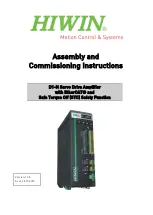
2
monitoring of correct amplifier functioning.
Extra equipment must be used to sample the
signal; e.g The Amplifier Surveillance Board
(ASB) from the SM 40 range may be used.
The outputs may be tapped at three different
voltages (100, 70 and 50 V) from the 100 V
output transformer.
Alignment and monitoring are accomplished
via a four position selector switch for
monitoring individual amplifiers via the VU
meter and headphones.
The unit is fitted with an emergency
48 V DC battery supply, which will
automatically power the unit in the event of
a mains failure, or if there is a significant
drop in the mains supply.
2 INSTALLATION
2.1 Mains supply voltage
The unit as supplied is suitable for mains
voltages of 220 - 230 V AC. For adaption to
mains voltages of 110, 127 and 240 V, the
required voltage has to be set accordingly. To
change the voltage, unplug the long grey
coloured screw connector from its connector
block (fig. 3.3), and rewire it for the
appropriate voltage (fig. 4). Push the
connector block firmly back into its place.
For mains voltages of 110 V and 127 V, the
4 amp (T) mains fuse built into the standard
“Europlug” has to be replaced by one with a
value of 8 amp (T) (see fig. 2 10 and 2.11).
To remove the mains fuse, first remove the
mains power lead from the socket at the rear
of the unit. Carefully insert a medium sized
screwdriver under the fuse cover’s small lip
(nearest the socket pins), and gently twist the
screwdriver to lever the fuse holder out.
A self-restoring thermal cut-out operates on
the primary winding of the mains
transformer.
WARNING:
When due to excessive temperature, the
thermal cut-out shuts down the amplifier
although the full mains voltage will still be
present inside the unit.
A suitable earthed AC mains distribution
socket should be provided inside the 19”
rack to provide power for the amplifiers. The
unit is supplied with a 2.5 m long mains
lead, terminated with a standard IEC two
pole earthed mains plug. In some countries it
will be necessary to replace this plug with
one of a local standard type.


































